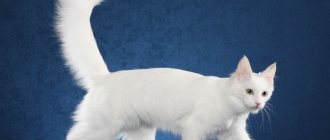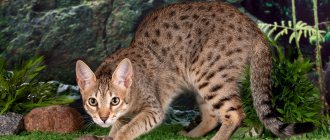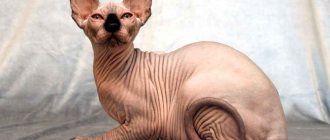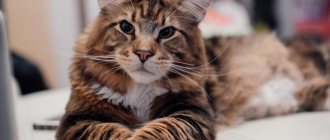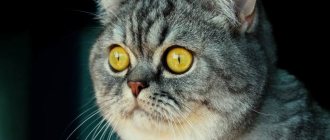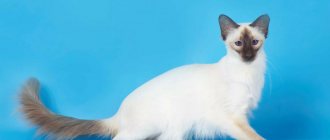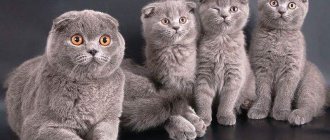Cats are diverse. Some people take a random pet, while others choose a pet based on certain external characteristics. For example, many cat lovers like cat breeds with tufted ears.
In fact, most long-haired cats have tufts on their ears, they are just mild and disappear completely as the animal grows older. But there are breeds of cats with ear tufts that are clearly defined, included in the standard and do not disappear throughout their lives.
Why do you need brushes?
Scientists have several versions regarding the tassels on the ears. Each of them has its own pros and cons. But the most likely are the following:
- The hard tufts of hair at the tips of the ears are analogous to an antenna and help amplify even the quietest sounds. It is not for nothing that the ancient Slavs revered the lynx because of its keen vision and very sensitive hearing. It was believed that the animal was able to hear the hunter’s steps several kilometers away and hide in time. An experiment was conducted that proved that when the tassels are removed, animals hear worse.
- Tassels are a kind of marker of the animal’s maturity. In an adult cat they are longer and darker. When a couple meets, the female can choose a more experienced, mature male, which increases the viability of the offspring.
- Tassels are beacons. Lynx is not only an excellent hunter. This beast is a master at hiding. It is believed that seeing a lynx is a sign of great luck. Tassels, visible to other animals and the cat’s relatives, will not allow you to invade its territory, and during the rut, it will not allow you to find a partner in the thicket.
It is obvious that wild cats need tassels for some reason, since centuries-old selection has preserved this trait to this day.
Many breeds have tassels. Kittens have them, but with age they hide in the pubescence of the ears or disappear completely. But there are 6 cat breeds for which ear tufts are a breed characteristic that persists throughout life.
Mr. Cat recommends: the best breeds
Below are the most striking representatives among felines with tassels.
Caraquet
This hybrid breed was bred at the Moscow Zoo in 1998 completely by accident, by crossing an ordinary cat and a caracal.
The caracat has a brownish-red coat color; an adult cat reaches almost 1 meter in length (including the tail). They also have long large paws, a small head compared to the body, large mobile ears with characteristic tassels.
Although this breed looks like a wild animal, the cat’s character is quite friendly and affectionate. Such a cat is in dire need of constant movement, so if you decide to have this handsome cat at home, you need to make sure there is enough space for him.
In addition, the caraqueta, like a dog, must be walked on a special leash-vest.
Kittens need to be bathed no more than once every three months, and adult cats - when dirty. It is necessary to ensure that a caracat with wet fur does not fall into a draft, otherwise there is a high risk of catching a cold.
Combing occurs 1-2 times a week, and in the summer during the molting period it should be done more often, preferably every day.
Food: raw meat (beef, poultry, rabbit, fish). Clean water should always be freely available to your cat.
You cannot give pork, cooked meat, or table food.
Read more about caracats, their history, content, see photos.
Maine Coon
This breed was obtained through natural hybridization in the USA more than a century ago.
Maine Coons are considered giants among cats. They have a good, strong body, wide bones and a massive muzzle. An adult cat can reach a weight of 15 kg (a male in rare cases can weigh up to 15 kg, the usual weight is 5-8 kg) and in isolated cases grows up to 1 meter in length. The coat is long and fluffy and comes in a variety of colors.
These cats are real good-natured people, but incorrigible lazy people. Maine Coons love to climb somewhere high and watch the bustle of the world from there. This breed is very attached to its owner, and it also differs from other cats in its “talkativeness” - cats make sounds that can be heard as unintelligible speech, and it seems as if they are trying to tell something.
Wool is the first thing the owner will have to take care of. The cat needs to be brushed daily.
These good-natured creatures bathe with great pleasure, but it is better not to arrange “bath procedures” too often, but to wash only when it is necessary to maintain hygiene.
Maine Coons are susceptible to developing periodontal disease, so do not forget about the cat’s oral cavity and buy special food to strengthen teeth.
They enjoy eating raw beef and boiled poultry meat, quail eggs and cottage cheese.
Pixie Bob
In the second half of the 20th century in the United States, breeders specifically tried to develop a cat breed that looked like a lynx, but with a short tail. Until the 80s, these experiments were inconclusive, until the work finally paid off. An individual was born, a cross between a domestic cat and a short-tailed forest cat.
They decided to name the breed “Pixie-Bob” (translated from English as “short-tailed elf”).
It has a stocky body, a large head and an animal look (due to deep-set eyes, looming, evil-looking eyebrows and a massive chin), a reddish fur coat with black spots, and a short thick tail. This breed is prone to an abnormality called polydactyly (extra toes). The ears are round and small; they do not always have tassels.
Short-tailed animals are quite friendly with people, but only one person is recognized as the owner - the one who feeds them.
Pixie Bob is an active breed that loves to play, but it is not recommended to have these animals in a house where other animals already live, otherwise there is a high risk of witnessing constant conflicts and merciless fights.
Due to his mobility, Pixie-Bob loves to walk in the fresh air, but it is better under the supervision of his owner, because. If a cat gets lost, it will go wild and is unlikely to ever approach a person again.
You need to comb the coat once a week, more often in the summer.
Cats of this breed are not picky eaters; they eat dry and wet food from the store with appetite. But if the owner decides to switch Pixie-Bob to natural food, then the cat should receive fresh meat every day.
Norwegian Forest Cat
As you can guess from the name of the breed, the homeland of these fluffy beauties is Norway. It has existed as a separate cat breed since the 70s.
An adult animal weighs about 8 kg. It is distinguished by long hair of white, black, red and gray colors. The Norwegian cat has a powerful skeleton, dense body, large paws, long whiskers and a bushy tail.
Norwegians are affectionate but energetic cats. By their “forest” nature they are hunters, so small animals and birds (hamsters, rats, chinchillas, canaries, etc.) will be in great danger around them. Despite their good-natured disposition, these cats do not allow themselves to be squeezed, especially by small children, who sometimes cannot control their strength.
The wayward Norwegian will allow himself to be stroked only when he wants it. If this cat doesn’t like the way its owners treat it, it will run away from home without a second thought and never return.
The breed is considered a record holder for life expectancy. With proper nutrition and proper care, this cat will be with its owners from 10 to 14 years, some can live up to 18 years.
Cats are also distinguished by their endurance, strength and immunity. The main thing for the owners of these “forest” animals is not to forget to brush their pets more often, get vaccinations in a timely manner and give the cat the opportunity to roam freely.
Norwegians are not afraid of even extreme cold; they feel comfortable at low temperatures.
Unlike Maine Coons, Norwegian Forest cats are “silent”; they will only give voice if there is an urgent need for it.
When it comes to food, the Norwegian breed is completely unpretentious, but the memory of wild ancestors still makes itself felt - the favorite food of forest cats remains finely chopped poultry or fish (always raw).
To prevent the cat from becoming infected with worms from raw meat, it is kept in the freezer for several days and only then, after defrosting, is it given to the animal to feast on.
Siberian cat
Representatives of this breed are semi-longhaired cats. For the first time, the “Siberian” became known in the 16th century, when these cats lived everywhere on the territory of the Russian Empire. Like any animal now considered domestic, the Siberian cat led a wild lifestyle until it was tamed.
They have a large and developed body, strong but not long legs. Females reach a weight of up to 6 kg, and males can be twice as large - up to 12 kg.
A distinctive feature of the Siberian is considered to be a rich fluffy collar around the neck and fur “pants” on the hind legs.
Their saliva contains less protein than other breeds, so this breed can be recommended for people prone to allergies.
A true “Siberian” has a calm disposition and a peaceful character. She gets along well with children, willingly cuddles up to people and is very attached to her owner.
There are many stories where representatives of this particular breed saved the lives of their owners during fires, gas leaks, etc.
Like Norwegian cats, Siberians are wonderful hunters. Living in rural areas near bodies of water, they love to go fishing or catch birds and rodents.
The Siberian cat is considered one of those breeds that live a long time, naturally, with high-quality and varied nutrition and care. Due to its endurance, the “Siberian” can rarely be affected by any illness. However, owners should carefully monitor cats to prevent urolithiasis.
Also, like all furry animals, Siberian cats are prone to clogging their intestines with hair, so it is important to comb out excess hair as often as possible during shedding and give special pastes to remove clumps.
Many owners suffer from high activity and playfulness of their pets, especially at night. The reason for this behavior lies on the surface - the cat is bored, it needs human attention and a variety of toys with which to occupy itself.
Usually, the owners of the Siberian cat do not have problems with feeding. The “Siberian” itself is omnivorous and unpretentious in food; its nature dictates that it eats natural food, i.e. meat, fish, eggs, etc.
Not allowed: fried and smoked. It is also worth considering that the Siberian cat has an unlimited appetite, she can eat often and a lot, so the main thing here is not to overfeed, so as not to have problems with weight.
Heavy weight, as you know, greatly shortens the life of a furry pet.
Chausie or Nile
This breed appeared as a result of an artificial combination of the gene of a domestic Abyssinian cat and a jungle cat in the 90s of the last century.
Chausie's fur is thick, but short, and has a silver-brown, gold or black color. The attribute of this breed is tufts on large ears (but not always) and a long black tail.
Chausies are incredibly inquisitive, active and loving pets. They can be housed next to other animals without any fear; this breed is completely non-conflicting. Cats need space, so cramped apartments are not suitable for these freedom-loving cats.
They quickly become attached to their owner, but do not like “calf tenderness”; by nature they are independent and are accustomed to expressing affection towards a person in their own way.
In terms of care, Chausie is completely unpretentious. Any conscientious owner can handle these cats. Taking care of your pet is standard: wash it when it gets dirty, clean its eyes, take care of its ears.
This breed is not considered sickly and picky, thanks to its wild feline ancestors, Chausie can boast of excellent health and strong immunity.
The only thing this cat desperately needs is a large space where it can run around to its heart's content.
Unpretentiousness in food is one of the main characteristics of Chausie. But the cat owner himself must understand that balanced and high-quality nutrition is the key to health for the four-legged family member. Therefore, dry food is an acceptable, but not the best option for nutrition. It is better to feed your hybrid cat raw poultry.
These are the most striking representatives of the cat family, with wild, but at the same time cute tufts on their ears. All varieties are beautiful and interesting in their own way, each has its own advantages, but the main thing for every pet is the care and love of the owner.
How to choose?
Dogs with long ears seem cuter and more attractive. The choice of a dog must be taken with great responsibility. The following must be taken into account:
- Features of the breed you want to purchase. Take into account character, habits, natural data.
- Adult dog size. From a small puppy, a dog can turn into a large representative of the Wolf, for whom the conditions of a small apartment will be torture.
- Hanging ears are not only beautiful, but also an additional concern. Find out in advance how and what to treat the ears, how often it needs to be done.
- Dog breeds with long ears differ from each other. There are options when the ears are covered with denser hair than the body. For some representatives they look compact, while for others they look comical.
- Focus on your taste, not on “fashion”. Trends are changing quickly, the average life expectancy of a healthy dog is about 12-15 years.
When choosing a dog with long ears, remember that this is an additional expense for funds and treatment.
Norwegian Forest Cat
Unlike European countries, in Russia this is a rather rare breed. Its representatives amazingly combine an aristocratic appearance and impressive size (the weight of adult individuals can reach 10 kg). Norwegian Forest Cats, also called Stogkatts, have the following characteristics:
- Tendency to wander when given the opportunity to walk freely on the street. There is no need to worry if during a walk your pet disappears from sight for several hours, or even the whole day. This is normal behavior for this breed.
- Good attitude towards children. “Norwegians” get along well with younger family members. Such a pet will not be offended if a child accidentally offends it. In response to too intrusive attention, he will prefer to retreat, waiting out the unpleasant situation in a secluded corner.
- The ability to find a common language with other four-legged inhabitants of the house.
- Low learning ability. This is not at all due to the low intellectual qualities of these animals. “Norwegians” understand perfectly well what they want to achieve from them with affectionate words and delicacy. They simply do not like to submit to other people's whims, preferring to make their own decisions.
- Curiosity.
- Excellent memory.
- A fairly quiet voice, which these cats use only in extreme cases.
- Playfulness. This quality is inherent not only in small animals, but also in older ones.
- Good health.
- The need for daily physical activity and a private place of solitude.
- Dislike of excessive attention.
Rare animal - caracat
This rare breed is the result of crossing a caracal with a Bengal cat. These exotic animals were born due to Irina Nazarova, in whose nursery in the period 2013–2017. 2 generations of these cats were obtained. The low demand for caracats is associated not only with their recent appearance, but also with their fairly high cost, as well as the need to create special conditions for them.
You can see in the photo what this animal looks like with a strong body, long legs, a chic sandy or silver coat and ears with tassels, like a steppe lynx. Features of this breed:
- Large sizes. These cats grow up to 45 cm in height, their body length is about 90 cm. The weight of an adult is 15 kg.
- Energy.
- Expressed hunting instincts.
- Ability to jump to significant heights.
- Nocturnal lifestyle. This quality is not inherent in all individuals.
- High intellectual abilities.
- Affectionate, gentle, balanced disposition.
- Independence and stubbornness.
- Good health.
- Inability to eat dry food. It is recommended to feed such a pet with natural food.
- The need for a large area for living.
- The ability to get along in the same territory with other pets. At the same time, it is better to prevent the caraquet from coming into contact with rodents and birds.
- Lack of aggression. Despite this, it is better not to leave children alone with this pet.
“Domestic lynx” – pixie bob
Born in 1986 in the United States, these short-tailed cats are considered a national treasure by many Americans. Outwardly, they look like a lynx; in fact, this was the task that the breeders set when creating this breed. They owe their name to a kitten named Pixie, which in English means “fairy” or “elf”. It was he who became the first successful result after many years of unsuccessful attempts to cross domestic cats with forest representatives of this family living in American and Canadian forests.
Pixie bob
These animals are often compared to dogs, and all because they are capable of becoming very attached to their owners and, in general, to the families in which they live. Not all of this quality is regarded as a virtue, because it is absolutely impossible to leave such a pet alone for a long time. Loneliness is contraindicated for pixie bobs. In the absence of a loved one for a long time, such an animal can fall into deep depression.


